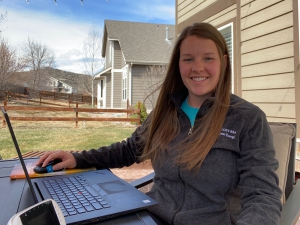Assess Your Energy Situation
By Derrill Holly and Amy Higgins
Staying at home can open your eyes to the changes that can benefit your castle — changes you may or may not have taken notice of before. Perhaps you’re noticing a draft around your windows and doors. Maybe you detected a hot spot in an area of your home that was previously overlooked. And with that, it’s conceivable that your electric bill is higher than it was last summer.
Better energy efficiency at home starts with savings, not sales, and an energy assessment conducted with help from a trained energy advisor from your electric cooperative can help you get there.
Some co-ops offer general assessments of the energy situation; some provide audits; all have expertise they can share. Co-ops are always there to answer questions about energy efficiency. In the past, some offered in-home assistance with energy questions. Others offered answers over the phone or via their website. As we move into our new “normal,” each Colorado co-op is finding ways to help its consumer-members answer their energy efficiency questions.
“In my opinion the biggest benefit for a member having an energy [assessment] is knowing exactly where your energy is going — if you’re being the most efficient with your energy that you can possibly be,” said Andy Molt, director of member services at Y-W Electric Association in Akron.
Co-ops provide this information because they are trusted energy advisors that are always working to help their members save energy and control their electricity costs.
“I’m usually looking for whatever problem the member has indicated, which could be high bills, a cold and drafty house or to check the efficiency of appliances,” said Alantha Garrison, energy use advisor at Gunnison County Electric Association in Gunnison, who has provided 535 assessments since 2010.
Members become frantic when they see a major increase on their power bill and want almost immediate answers as to why. In conjunction with experience and the ability to refer to meter data reports, the process of identifying major power consumption problems has been simplified and resolved in many instances.
Problems, such as poor insulation or air leaks from windows and doors, can be identified rather quickly using a thermal camera. “I can actually look and see if there are voids in the insulation and walls with [a thermal camera],” Molt said. Interestingly, Molt said he not only finds insulation problems in older homes, but sometimes also finds “huge voids” in the insulation of newer homes.
Energy advisors are constantly receiving training, certifications and reading materials to hone their skills. During on-site assessments, energy experts use all their senses and teachings to find abnormalities, such as hot water line leaks, running well pumps or damaged power cords. Their close examination sometimes leads to identifying safety issues as well.
Amy Blunck, communications director at Fort Collins-based Poudre Valley Rural Electric Association, shared that during one walk-through assessment, they found an old, metal surge strip that was malfunctioning. “It had burned a hole in the back of the strip, and it was arcing,” she explained. “This surge strip was in a barn sitting next to a pile of wood, and it could have burned the whole barn down if not discovered.”
Expert advice
Many of the electric co-ops that provide energy advice support professional development for energy advisors that includes exposure to building science concepts.
Training focused on both new construction techniques designed to improve energy efficiency and retrofitting options for upgraded older housing are common. Specialized training for multifamily units and manufactured housing are also common.
“By providing a picture of how energy is used in the home, people can concentrate on what can save them the most energy,” said Eileen Wysocki, an energy auditor with Holy Cross Energy, headquartered in Glenwood Springs.
Wysocki starts with a baseload estimate of energy use based on meter data. Talking with the consumer-member, she learns about household size and behavior patterns, and considers seasonal factors like heat tape used to prevent water lines from freezing during winter months.
“We have many ‘second homes’ in our service territory,” Wysocki said, adding that even when those homes are empty, energy use continues. “Fan coil blower motors, whole house humidifiers, boiler pumps, ventilation systems, driveway snowmelt pumps, pool pumps, hot tubs, garage heaters, heated toilet seats and towel bars are using energy, regardless of occupancy.”
The co-op serves Colorado’s popular ski areas around Aspen and Vail, and is currently designing a new audit form. It will stress benefits members can receive through efficiency upgrades, including comfort, said Mary Wiener, energy efficiency program administrator for Holy Cross Energy.
While some co-ops provide assessments free of charge, especially when they are requested in response to high bill concerns, others may charge a small fee, offering rebates to members who implement some of the recommendations provided.
An energy advisor can help a member avoid ineffective upgrades or the purchase of outsized equipment that might not improve their comfort or produce savings through recoverable costs.
“For members, simply talking to us on the phone about their energy use or asking us to help them find the problem at their home or business often answers their questions, and they start to understand how much control they have over their own costs when it comes to their electric bill,” Blunck explained. “Understanding that something as simple as using a smart thermostat, where they can control the temperature so their kids aren’t constantly turning up the AC, or putting the donkey up in a corral, where he can’t get to the stock tank heater cord, can make a big difference in your electric bill.”
Offering solutions
Most energy assessments are initiated following a request tied to high bill concerns, when members are really motivated to control their energy costs.
On average, members can reduce their energy use by about 5% if they follow the low-cost or no-cost advice given after an assessment. Additional savings of up to 20% can be achieved by addressing issues with big-ticket items, such as heating and cooling replacement, adding attic insulation or major duct damage discovered during the assessment.
Improved energy efficiency not only helps the co-op control peak demand and wholesale power costs, it also provides opportunities to discuss services available to members. Those include rebates, weatherization programs and payment assistance.
So, what are the biggest benefits of having an energy review? “Finding areas to air seal; learning specific habit changes that can make a difference; learning when it’s most expensive to use power; learning how much energy different items use, so you know what to expect on your energy bill; learning about new co-op programs you might not have known about,” Garrison said, adding, “also, if you have a pet, I’ll probably take an infrared image of it to send to you, which people love.”
To learn more about energy assessments available to you, contact your local electric cooperative.
Derrill Holly writes on consumer and cooperative affairs for the National Rural Electric Cooperative Association.
Amy Higgins has been writing for Colorado Country Life for nearly a decade focusing on the topics that make a difference in the lives of its readers.






 COVID-19 has had a detrimental effect on lives, livelihoods and the economy worldwide, and experts don’t envision a sudden “return to normalcy,” but following the guidelines presented by our health experts and legislators can help us get on the road to recovery.
COVID-19 has had a detrimental effect on lives, livelihoods and the economy worldwide, and experts don’t envision a sudden “return to normalcy,” but following the guidelines presented by our health experts and legislators can help us get on the road to recovery.